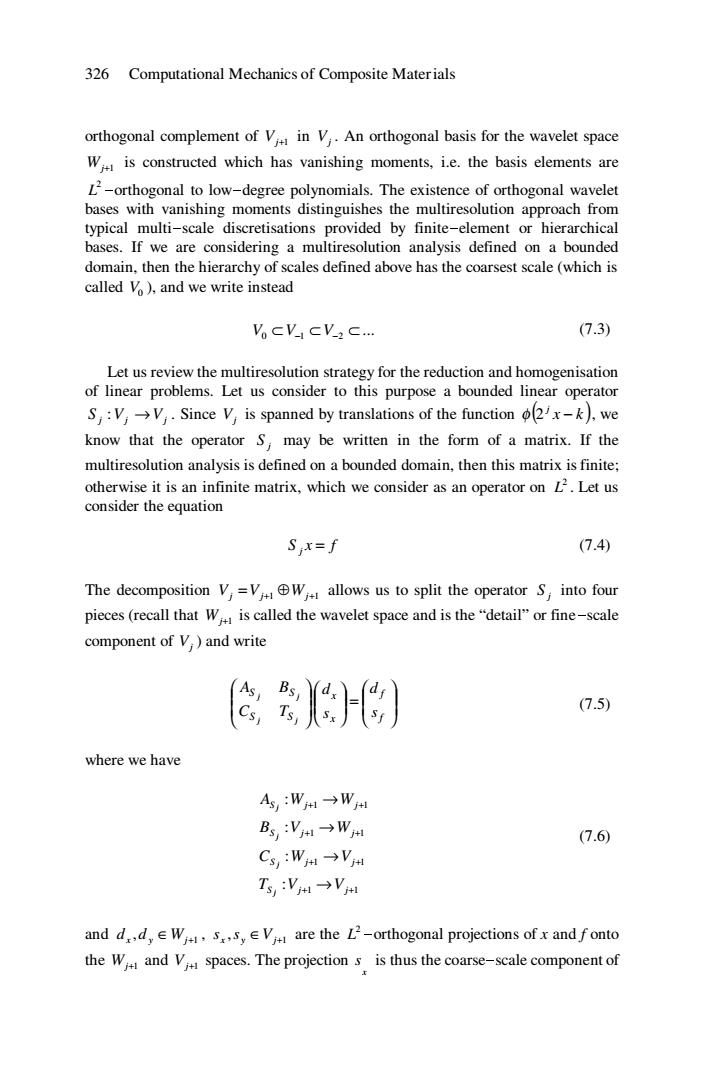正在加载图片...

326 Computational Mechanics of Composite Materials orthogonal complement of V in V,.An orthogonal basis for the wavelet space Wis constructed which has vanishing moments,i.e.the basis elements are L'-orthogonal to low-degree polynomials.The existence of orthogonal wavelet bases with vanishing moments distinguishes the multiresolution approach from typical multi-scale discretisations provided by finite-element or hierarchical bases.If we are considering a multiresolution analysis defined on a bounded domain,then the hierarchy of scales defined above has the coarsest scale (which is called V),and we write instead VocV1cV-2c.… (7.3) Let us review the multiresolution strategy for the reduction and homogenisation of linear problems.Let us consider to this purpose a bounded linear operator S,:VV,.Since V,is spanned by translations of the function x-k).we know that the operator S,may be written in the form of a matrix.If the multiresolution analysis is defined on a bounded domain,then this matrix is finite; otherwise it is an infinite matrix,which we consider as an operator on L2.Let us consider the equation Six=f (7.4) The decomposition V=VW allows us to split the operator S,into four pieces(recall that W is called the wavelet space and is the"detail"or fine-scale component of V,)and write 色)H) (7.5) where we have A,:W*→W Bg,:V#1→W (7.6) Cs,:Wn→VH T,:V#→V and dd,W.ss,V are the L2-orthogonal projections of x and fonto the W and V spaces.The projection s is thus the coarse-scale component of326 Computational Mechanics of Composite Materials orthogonal complement of Vj+1 in Vj . An orthogonal basis for the wavelet space Wj+1 is constructed which has vanishing moments, i.e. the basis elements are 2 L -orthogonal to low-degree polynomials. The existence of orthogonal wavelet bases with vanishing moments distinguishes the multiresolution approach from typical multi-scale discretisations provided by finite-element or hierarchical bases. If we are considering a multiresolution analysis defined on a bounded domain, then the hierarchy of scales defined above has the coarsest scale (which is called V0 ), and we write instead ... V0 ⊂ V−1 ⊂ V−2 ⊂ (7.3) Let us review the multiresolution strategy for the reduction and homogenisation of linear problems. Let us consider to this purpose a bounded linear operator S j Vj →Vj : . Since Vj is spanned by translations of the function ( ) x k j φ 2 − , we know that the operator S j may be written in the form of a matrix. If the multiresolution analysis is defined on a bounded domain, then this matrix is finite; otherwise it is an infinite matrix, which we consider as an operator on 2 L . Let us consider the equation S x f j = (7.4) The decomposition Vj =Vj+1 ⊕Wj+1 allows us to split the operator S j into four pieces (recall that Wj+1 is called the wavelet space and is the “detail” or fine-scale component of Vj ) and write ⎟ ⎟ ⎠ ⎞ ⎜ ⎜ ⎝ ⎛ =⎟ ⎟ ⎠ ⎞ ⎜ ⎜ ⎝ ⎛ ⎟ ⎟ ⎠ ⎞ ⎜ ⎜ ⎝ ⎛ f f x x S S S S s d s d C T A B j j j j (7.5) where we have 1 1 1 1 1 1 1 1 : : : : + + + + + + + + → → → → S j j S j j S j j S j j T V V C W V B V W A W W j j j j (7.6) and 1 , dx d y ∈Wj+ , 1 , x y ∈Vj+ s s are the 2 L -orthogonal projections of x and f onto the Wj+1 and Vj+1 spaces. The projection x s is thus the coarse-scale component of